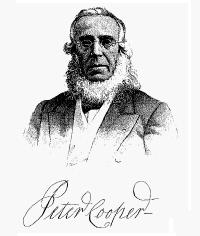
Peter Cooper started making gelatin as a natural outgrowth of his very
first business venture; a glue factory. The following is quoted from "Glue
and Gelatin" by Jerome Alexander (American Chemical Society Monograph Series,
Chemical Catalog Co., New York NY, 1923). Note the mention that gelatin
dishes were popular in Europe as early as the Napoleonic period.
One of Peter Cooper's many patents associated with the manufacture of
glue and gelatin is also mentioned. Additionally, Peter Cooper was responsible
for introducing general manufacturing standards for glues and gelatins
that remained in use for decades. His standard for glues was called the
"Cooper grade." His son and his son-in-law eventually took over the business
so that he could dedicate himself to other pursuits, including serving
in the New York City government, building a successful telecommunications
corporation (the North American Telegraph Company) and running for President
as the candidate of the Greenbacks Party. His grandson and namesake, Peter
Cooper-Hewitt, invented the mercury-vapor lamp, the quartz-tube mercury
lamp and the mercury rectifier. He also figured out the physics behind
the vacuum-tube amplifier.
Historical
"...Glue and gelatin, like most other manufactures of early days, were
produced by individual artizans for their own use, and even to-day some
paper and textile mills boil their own glue size from rawhide cuttings.
From these somewhat primitive methods, the real glue and gelatin industry
emerged about the beginning of the nineteenth century. In France the industry
started in the vicinity of Lyons, and for many years these factories were
the most important of their kind in Europe. During the Napoleonic era extravagant
claims were made as to the food value of gelatin, and probably this was
one reason why the industry was fostered."
"Germany apparently appreciated the importance of the manufacture of
glue and gelatin as a key industry, for a German company organized in 1895
with three plants, expanded until in 1912 it controlled the output of seventeen
plants, and has also factories in Austria, Belgium, Switzerland, and France."
The Glue Industry in the United States.
"According to Rufus W. Powell ("Glue Statistics, Brooklyn, 1893) it is
very difficult to obtain exact information about the glue manufacturing
industry in the United States prior to 1860; but those long in the business
reported that outside of regular glue manufacturers, a great many tanners
boiled up their own stock in open kettles. The principal factories sem
to have been in the vicinity of Boston, New York, Philadelphia and later
on Cincinnati. One of the pioneer factories was at Marblehead, Mass., and
probably secured its stock from the tanneries at Salem and Lynn. Peter
Cooper's factory was on Newtown Creek, Long Island, now in the Borough
of Queens, New York City..."
Technology of Glue and Gelatin - Chilling.
"In most factories the glue liquors, after evaporation and other treatment,
are poured into small rectangular galvanized iron pans and allowed to gelatinize,
preferably in a chill room. Sometimes the pans are allowed to stand in
cold water. Many European factories have casting tables, which form
the glue diredctly into cakes. These tables have hollow tops through which
is circulated cold water or brine; the upper surface (of metal or glass)
is divided into square or oblong recesses which are filled with the glue
liquor and which often have a trade mark etched in, so that it appears
on the glue cake."
"Many devices have been patented for chilling concentrated glue liquor
into a continuous sheet, which is automatically spread upon nets. None
of these have found general widespread use, and several have been tried
and abandoned. One of the early patents was that of Peter Cooper-Hewitt
[Note: Peter Cooper-Hewitt was Peter Cooper's grandson] (U.S.P. No. 11,426,
issued 1894). Some of the European gelatin factories are said to employ
such apparatus."
Standard Glues.
"Although no official unanimity of standards exists even now, for nearly
a century [note; this is relative to 1923; in 1997 this would be closer
to 175 years]. American manufacturers have been using a series of loosely
fixed standards based upon those established by Peter Cooper, the well-known
philanthropist, who was an American manufacturer of glue..."

